Maven's Nest
Reel Life: Flick Pix
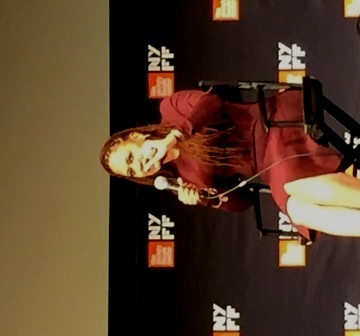
---Director Ava DuVernay at the press conference before the World Premiere of 13th at the 2016 New York Film Festival.
Women directors re-making history
By Nora Lee Mandel
Women directors shone at the 54th Annual New York Film Festival of Film Society of Lincoln Center, September 30 through October 16, 2016 with 40 features and shorts in a wide variety of styles. Here’s my Festival highlights of women directors who brought new perspectives to history documentaries beyond Ken Burns’s techniques.
The best women-directed documentaries in this edition of the New York Film Festival notably expanded the documentary genre:
Challenging The Past: 13th, The Illinois Parables and What Happened To Her
Innovative Memoirs as History: Karl Marx City and Brillo Box (3¢ Off);
Trapped in History: The Cinema Travellers and Cuba, Fatherland Or Death (Patria O Muerte));
Challenging The Past
13th
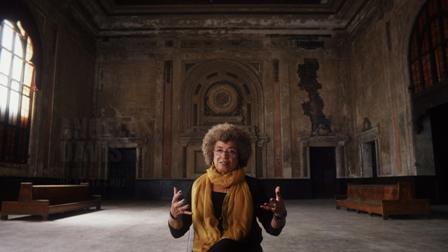
Opening Night was a prestigious showcase for Ava DuVernay’s 13th, a radical and extremely relevant re-telling of the history of race relations in the United States, as the first nonfiction work to ever lead off the Festival. When the 13th Amendment was touted in school as officially ending slavery after the Civil War, how many of us have thought through the catch: “Neither slavery nor involuntary servitude, except as a punishment for crime whereof the party shall have been duly convicted, shall exist within the United States.” You’ll never forget the societal impact after this must-see examination. DuVernay pointedly noted at the press conference for this World Premiere that its immediate global release on Netflix “gets around art-house theater segregation. . .Documentaries don’t play in the neighborhoods or the multiplexes.” (Limited simultaneous theatrical release also assures its Oscar eligibility.)
DuVernay returned to her early experience in documentaries right after the Oscars ceremony where Selma was nominated, and she continually updated through this summer, extending the historical reach to this presidential campaign. Inspired by former ACLU lawyer/now professor Michelle Alexander’s 2010 treatise The New Jim Crowe: Mass Incarceration in the Age of Colorblindness, DuVernay wanted to bring the facts and the fury to a wide audience. Alexander is included among the many “talking heads”, with each interview set in a visually striking space (Angela Davis in a soaring old railroad station - above), while the camera constantly (sometimes annoyingly) moves around the speakers of different political angles from different camera angles. Besides historians, like Khalil Gibran Muhammad who also participated in a follow-up free panel and podcast, the forceful interviewees include the ex-incarcerated, young women #BlackLivesMatter activists, and Republicans, such as Newt Gingrich.
In very effectively repeating and juxtaposing a hundred years of archival images and dicing code words by politicians, the film, for example, makes a visceral comparison between the popular postcards of lynchings and the YouTube clips of police killings of black people. But each of the cell phone captures is carefully labeled “used with permission of the family”, making us realize that we never see that thoughtful consideration on the TV news. (DuVernay credited her sister with the empathetic fortitude to reach out to each family about their loved ones’ last moments.) She visually emphasizes how popular culture has implanted the image of the black male as a criminal since D.W. Griffith’s Birth of a Nation in 1915 by contrasting the fictional with real footage of a formally dressed black man set upon by a white mob, repeated in slo-mo to sharp effect about the impact on real behavior. Also shown in the Festival, Raoul Peck’s stunning I Am Not Your Negro, in “Spotlight on Documentary” and released in theaters by Magnolia, further criticizes cinema stereotypes through James Baldwin’s acerbic comments on a plethora of genre clips.
Between the impassioned (though sometimes jargon-filled) interviews, DuVernay flashes animated statistics and graphs on the whole law enforcement system’s institutionalization of subjecting African-Americans to more arrests by the police, for higher charges by prosecutors, bail, fines, and parole violations than whites, for a vicious cycle of long indebtedness to the criminal justice system. National and Congressional “law and order” politics over decades are eviscerated to show how judges had to set disproportionately longer sentences, with any ameliorations continually weakened in compromise.
On an industrial scale, these black bodies feed the profitable system of maintaining large prisons, including phone and food services, and employment in rural areas. Beyond other documentaries on private jails, she zeroes in on how felons cannot qualify for most housing, food, income, health, and employment benefits, so there are devastating negative multiplier economic effects on their families and their communities. Politically, disenfranchisement of felons, not only in ex-Confederate states, can rise to one in five adult blacks for life– supporting the charge that mass incarceration has become “the New Jim Crowe”.
Hopefully, the enormity of the charges and DuVernay’s clarion call for systemic changes are not too overwhelming, but will help channel viewers’ anger into action and progress.
THE ILLINOIS PARABLES

In the most unusually structured solo program, my favorite in the avant-garde Projections section, American director Deborah Stratman’s eleven shorts are each allegorical histories of settlement, removal, technological breakthrough, violence, messianism, and resistance, all taking place in the state of Illinois, from pre-AD through the 20th century.
More than a new, visual WPA Guide to the state, the hour-long, thematically linked experimental documentary “suite” uses strong resonant images, with some re-enactments, to show how the land and the prairie landscape doesn’t forget the past, though these time and place labels don’t appear until the final credits:
I- Cahokia, IL 600-1400 CE – with the shaman Ravenwolf (Raven Wolf C. Felton Jennings II – above) drawing strength from the land;
II- Alton, IL 1673 – the explorer Jacques Marquette (José Oubrerie) records the “monsters” he sees in this New Land, even as he also sees cave drawings;
III- Golconda, IL- Jonesboro, IL 1838-1839 – Native Americans become residents of dioramas and traces in geographical names, even as we can hear “The Trail of Tears” when they are removed and commentary by Alexis de Tocqueville (Daniel Verdier) and Ralph Waldo Emerson (David Gatten);
IV- Nauvoo, IL 1839-1848 – pioneer images of a refuge for religious freedoms take a darker turn as a Mormon tour guide describes the genocidal violence that drove them out;
V- Icaria/Nauvoo, IL 1849-1860 – vestiges of the longest surviving secular communal society in the state;
VI- Gorham, IL - Crossville, IL 1925 – natural disasters like tornadoes happened before 24/7 cable news - microfilm of newspapers reveal the heartbreak of hundreds dead from “Five Minutes of Terror”, with reenacted sounds, that turned southern Illinois into a cemetery;
VII- Chicago, IL 1942 – where physicist Enrico Fermi (Joshua Friedman) ponders belief and nationhood amidst mathematical formulas, and a marker warns “radioactive material from nuclear research here 1943 – 1949”;
VIII>- Joliet, IL 1940-1976 – where grass-covered bunkers are only decorated with racist warning signs;
IX- Macomb, IL 1948 – conspiracy theorists have a literal field day with mysterious fires;
X- Chicago, IL 1969 - Fred Hampton’s voice for revolution is heard amongst the evidence of the FBI’s war on the Black Panthers; and
XI- Buffalo Rock, IL 1985 – the voices of a mournful chorus rise as the camera does, over prairie, fields, forests, and rivers, beautifully summarizing the geological and social history of the State of Illinois.
This unusual interpretation of American history has been getting limited theatrical runs around the country, including at Anthology Film Archives November 2016.
WHAT HAPPENED TO HER
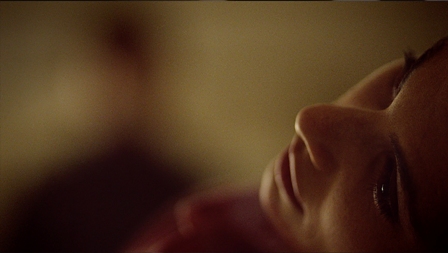
Cinematic stereotypes are also powerfully amassed to alarming effect in just 15 minutes by director Kristy Guevara-Flanagan, as shown in the Main Slate of Shorts “Genre Stories”. She forces the viewer to see that the naked (usually white and young) female corpse is such a mainstay of cop shows and movies that we have become far too inured to her presence.
Over the deluge of clips and scenes, former actress Danyi Deats remembers what it was like playing a dead girl in Tim Hunter’s River's Edge (1986) when she was 19, and how she was asked to reveal more and more in an uncomfortable setting. “My make up took two and half hours in the morning. I always thought it was sad I come out looking like a corpse and the other actors come out looking beautiful.” Besides the iconic image of dead Laura Palmer (Sheryl Lee) in David Lynch’s original Twin Peaks, the scenes, from what seems like every cop flick and CSI-like crime series, pile on uncomfortably, as the bodies – in water, earth, and especially the morgue -- look more bruised. This powerful short made me reluctant to watch his re-vamped Twin Peaks.
Guevara-Flanagan’s earlier Wonder Women! The Untold Story of American Superheroines (2012) is getting renewed attention due to the U.N. marking Wonder Woman’s 75th anniversary by designating her “an Honorary Ambassador for the Empowerment of Women and Girls to achieve gender equality and empower all women and girls” and the release of Patty Jenkins’ big-screen hit. But her new, far starker film forces us to think carefully, and to protest, about how the images of women’s bodies have been shown over almost as many decades that some now term “crime porn”. I hope this frank “forensic exploration”, as the director calls her approach, has an impact on filmmakers, at least to support actresses who object what directors try to push them to do.
Innovative Memoirs as History
KARL MARX CITY
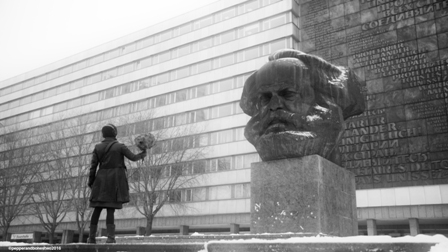
Petra Epperlein ironically haunts the people and places in the former East Germany (GDR) of her youth with headphones and a fuzzy-covered microphone, filmed by her husband/co-director Michael Tucker in sharp black-and-white like a Cold War noir mystery. (They have previously focused on soldiers of the current “hot” war, including The Prisoner Or: How I Planned To Kill Tony Blair.) Eerily interspersed with actual government surveillance tapes, the punk blonde in black spies on the past to uncover the truth about a ghost, her beloved father who burned his personal papers then committed suicide ten years after the Berlin Wall fell. Why?
In searching for a reason, she gains mature insights about her family, her neighbors, and the true nature of the society around them. Her mother shows her the anonymous notes sent to her father’s West German boss in the 1990’s claiming he had been an informant for the dread Stasi State Security Ministry. She interviews historians and intelligence experts for the context on how the country’s omnipresent surveillance worked in general, and its insidious impact; one tells her that an estimated 10% of the population also committed suicide after the fall. For the personal angle, she talks to family and neighbors in her own hometown, then known as the industrial center Karl-Marx Stadt, now returned to its original name of Chemnitz, but still dominated by a monumental bust of Marx that’s too big to remove, so is still watching.
She returns several times to former Stasi headquarters to file the necessary paperwork to see if their surveillance records will reveal an answer or clues, then she and her mother wait and wait. I’ve toured that complex in Berlin, and it embodies the banality of evil in its middle class office décor. So how fitting that what they finally learn of the betrayal, it was by the most unexpectedly banal informant. BOND/360 released Karl Marx City in theaters.
BRILLO BOX (3¢ OFF)
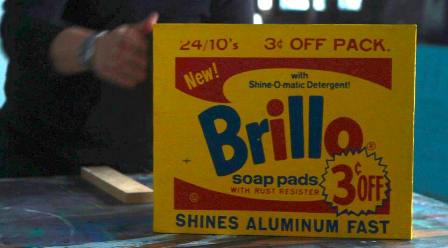 (Photo Courtesy of HBO)
(Photo Courtesy of HBO)
One of my favorites in the new documentary shorts section, American director Lisanne Skyler delightfully combines family memoir (with photos) and pop art history (through quick montages) in just forty minutes: “In 1969, my parents bought an Andy Warhol Brillo Box for $1,000. An exact replica of the popular Brillo soap pad product package, Warhol’s Brillo Boxes were at first dismissed by the art world. But forty years later, in 2010, the same sculpture sold for $3,000,000 at a record-breaking Christie’s auction. This is the story of what happened in between.”
She also warmly evokes the kind of intellectual New York families I knew growing up, like my parents’ and several of their friends, who dabbled in art collecting around the same time, in the late 1960’s – 1970’s. As each now-divorced parent gives their very different attitudes towards this and other pieces in their art collection, perhaps if her parents were really serious art collectors without kids they could have been Herb & Dorothy Vogel.
Their daughter goes beyond family memories and photos posed with their rare autographed, and one of only 17, small yellow boxes, that they even protected from the kids with plexiglass. By moving from a well-lived living room to [ka-ching price goes up] contemporary art world luminaries like Charles Saatchi who was the next owner (for five years) and on to [ka-ching price goes up] ownership by the founding director of the Los Angeles Gagosian Gallery (for 20 years until his death prompted the [ka-ching price goes up] auction), she gets to the very essence of the irony of pop art as an aesthetic object that mocked commercial culture. Taking the full 360 degree approach to the subject, including the perspective of the head of the company that owns the Brillo brand, and she finally tracks down, with great effort, the “up and coming” artist whose work her father bought to replace “The Brillo Box” in their home. HBO will premiere on August 7.
Trapped in History
THE CINEMA TRAVELLERS

That kind of special moment in Sullivan’s Travels when poor, tired farm workers gather together at night to enjoy a movie projected onto a sheet has been repeated all over rural India for 70 years, courtesy of traveling cinemas. Courtesy of directors Shirley Abraham and Amit Madheshiya, we get to see that light come on many times in the projectors and in old and young faces. They first climbed on board the gritty trucks with big, old 35 mm projectors trudging down dirt roads at harvest time and annual religious fairs throughout the large western state of Maharashtra in 2008 to research how people watch film in the villages of India. As Abraham collected oral histories and Madheshiya took award-winning photographs, they realized by 2011 the technology and thus the business was changing. For their first feature, they document in verité style, with great sympathy, three men who represent the old mode, the challenges to change, and the attempt to adapt to the new world of digital television – much as Bollywood and Hollywood distributors are, too.
Bapu is a long-time showman always hustling for audiences and people respond to his flashy, Barnum-like promotion with excited anticipation. (Some prefer local Marathi-language films, but are dazzled by Bollywood musicals in Hindi.) Prakash is the last repairman of the clunky, mammoth projectors, and has shelves full of old ones he creatively cannibalizes to help keep the last few operating as more traveling cinemas stop. (The 35mm films are also being discarded; the difficult effort to preserve this legacy has been documented in Celluloid Man.) The younger Mohammed is getting frustrated at the difficulty of even getting 35mm prints and braves the complicated new world of digital (and a modern salesman). In what may be the source of India’s fascination with cinema, the salesman makes time to show Mohammed around “one of the oldest arts” -- ancient cave carvings he briefly illuminates by flashlight, recalling Werner Herzog in Cave of Forgotten Dreams. He laughs that cinema in comparison is “a newborn”.
While the recent short film Ozoners similarly tracked the last of the American drive-ins with their huge 35mm projectors, the sights and sounds of India (replete with the rich score by Laura Karpman and Nora Kroll-Rosenbaum with flutes, violins, cello, guitars, keyboards, vocals, taal, harmonium, tabla, bansuri, ektara, dholak, dimdi, and harmonium) rise above ethnographic interest to showcase the universality and brotherhood of dedicated film fans, and is continuing traveling on the international festival circuit, including in India’s New Wave at Museum of the Moving Image.
CUBA, FATHERLAND OR DEATH (PATRIA O MUERTE)
Interspersing archival images of the history of Cuba before, during, and after the Revolution, director Olatz López Garmendia films thoughtful interviews with a variety of Cubans (old and young, men and women), particularly artists, musicians and writers, about their hopes for the future, as the buildings and technologies of the past crumble around them. Time passing is indicated as Castro ages, and they all feel they’re floating in limbo. The tropical beach is always beautiful, and tantalizingly close to the United States, where she also talks to exiles in Miami. Everybody longs for freedom and connections between the island and the modern outside world. (HBO Documentary)
updated 7/15/2017
Nora Lee Mandel is a member of New York Film Critics Online and the Alliance of Women Film Journalists. Her reviews are counted in the Rotten Tomatoes TomatoMeter:

Complete Index to Nora Lee Mandel's Movie Reviews
Since August 2006, edited versions of most of my reviews of documentaries/indie/foreign films are at Film-Forward and, since 2012, festival overviews at FilmFestivalTraveler. Shorter versions of my older reviews are at IMDb's comments, where non-English-language films are listed by their native titles.
To the Mandel Maven's Nest Reel Life: Flick Pix
Copyright © 2018






 (Photo Courtesy of HBO)
(Photo Courtesy of HBO)

